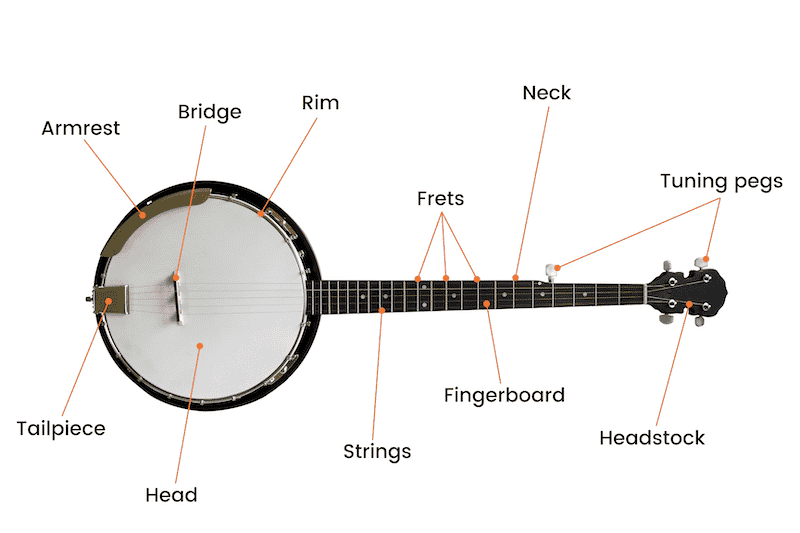If you are a music enthusiast, then you are likely familiar with the banjo, a stringed instrument that is commonly associated with folk, bluegrass, and country music. The banjo has a unique and distinctive sound, and its construction is fascinating. In this article, we will explore the anatomy of a banjo, examining its various parts and their functions.

Anatomy of a Banjo
- The Head
The head of the banjo is the circular piece of material that covers the top of the banjo’s body. It is usually made of plastic or animal skin, and it is stretched tightly over the banjo’s rim. The head is essential to the banjo’s sound, as it is responsible for resonating the sound produced by the strings. The type of head used can greatly impact the tone and projection of the banjo.
- The Rim
The rim of the banjo is the wooden hoop that forms the body of the instrument. It is usually made of maple or other hardwoods, and it is responsible for providing a sturdy frame for the banjo’s other components. The rim also plays an important role in shaping the banjo’s sound, as it helps to amplify the vibrations produced by the strings.
- The Tension Hoop
The tension hoop is a metal ring that fits around the outside of the banjo’s rim. It is responsible for holding the banjo head in place and keeping it taut. The tension hoop is typically made of nickel or brass, and it is adjustable, allowing the player to tighten or loosen the banjo head as needed to achieve the desired sound.
- The Flange
The flange is a metal ring that sits on top of the banjo’s tension hoop. It serves as a mounting point for the banjo’s resonator or back, which is responsible for projecting the sound of the banjo forward. The flange is typically made of brass or nickel, and it is attached to the banjo’s rim using screws.
- The Resonator or Back
The resonator or back of the banjo is a curved piece of wood that sits on the back of the banjo’s rim. It is responsible for reflecting the sound produced by the banjo’s strings forward, giving the instrument its characteristic volume and projection. The resonator or back is usually made of hardwood and is often adorned with decorative inlays.
- The Neck
The neck of the banjo is the long, thin piece of wood that extends from the banjo’s body. It is usually made of hardwood, such as mahogany or maple, and it is responsible for supporting the banjo’s fingerboard and tuning pegs. The neck is an important component of the banjo, as it greatly impacts the instrument’s playability and overall sound.
- The Fingerboard
The fingerboard is the long, narrow strip of wood that sits on top of the banjo’s neck. It is usually made of ebony or rosewood and is responsible for holding the banjo’s frets. The fingerboard is an essential component of the banjo, as it allows the player to produce different notes and chords by pressing down on the strings.
- The Frets
The frets are the small metal bars that sit on top of the banjo’s fingerboard. They are responsible for dividing the fingerboard into different sections, allowing the player to produce different notes and chords. The placement of the frets is crucial to the banjo’s sound, as it determines the pitch of the notes produced.
- The Strings
Of course, no banjo would be complete without strings. Banjos typically have five strings, although some models may have four or six. The strings are typically made of steel or other metal alloys, which give them a bright, sharp tone. The strings are held in place at the top of the neck by a set of tuning pegs, which allow the player to adjust the pitch of each string.
10. The Bridge
The bridge is the small, wedge-shaped piece of wood that sits on top of the head of the banjo. It’s positioned between the strings and the head, and serves to transfer the vibration of the strings to the head, creating the sound of the banjo. The bridge is held in place by the tension of the strings, and can be adjusted slightly to fine-tune the sound of the instrument.
More Banjo Articles
Origins and History of the Banjo
